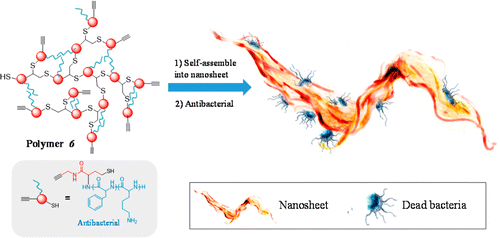Synthesis and Mechanism Insight of a Peptide-Grafted Hyperbranched Polymer Nanosheet with Weak Positive Charges but Excellent Intrinsically Antibacterial Efficacy
作者:Jingyi Gao, Mingzhi Wang, Fangyingkai Wang, and Jianzhong Du* 时间:2016-05-14 点击数:

Abstract
Atimicrobial resistance is an increasingly problematic issue in the world and there is a present and urgent need to develop new antimicrobial therapies without drug resistance. Antibacterial polymers are less susceptible to drug resistance but they are prone to inducing serious side effects due to high positive charge. Herein we report a peptide-grafted hyperbranched polymer which can self-assemble into unusual nanosheets with highly effective intrinsically antibacterial activity but weak positive charges (+ 6.1 mV). The hyperbranched polymer was synthesized by sequential Michael addition-based thiol–ene and free radical mediated thiol–ene reactions, and followed by ring-opening polymerization of N-carboxyanhydrides (NCAs). The nanosheet structure was confirmed by transmission electron microscopy (TEM) and atomic force microscopy (AFM) studies. Furthermore, a novel “wrapping and penetrating” antibacterial mechanism of the nanosheets was revealed by TEM and it is the key to significantly decrease the positive charges but have a very low minimum inhibitory concentration (MIC) of 16 μg mL–1 against typical Gram-positive and Gram-negative bacteria. Overall, our synthetic strategy demonstrates a new insight for synthesizing antibacterial nanomaterials with weak positive charges. Moreover, the unique antibacterial mechanism of our nanosheets may be extended for designing next-generation antibacterial agents without drug resistance.
文章链接:Biomacromolecules 2016, 17, 2080-2086.